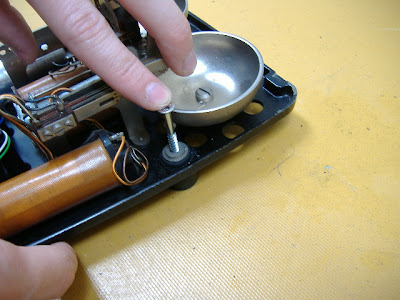The Problem: A Tale of
Two Technologies
The fundamental issue lies in how these two systems "talk" to each other. Old rotary dial phones use a method called pulse dialing (also known as loop disconnect signaling). When you dial a number, the rotary mechanism interrupts the electrical current in the phone line a specific number of times. For example, dialing a "4" sends four quick electrical pulses to the exchange. The exchange then interprets these pulses to connect your call. It's a simple, brilliant, and entirely mechanical system.
However most modern VoIP systems don't understand pulse dialing. They rely on a completely different language called Dual-Tone Multi-Frequency (DTMF), or what we commonly know as "touch-tone" dialing. When you press a key on a modern keypad, it generates two distinct tones—one from a low-frequency group and one from a high-frequency group. The combination of these two tones is unique to each number, and the VoIP adapter recognizes this pattern to route the call. Think of it this way: a rotary phone is speaking in Morse code, while a VoIP line is listening for musical notes. They simply can't communicate directly.
The Solutions: Bridging the Gap
1. The Pulse-to-Tone Converter.
This is the most popular and straightforward method. A pulse-to-tone converter is a small, external box that sits between your rotary phone and the VoIP adapter. The converter's job is simple: it "listens" for the electrical pulses from the rotary dial and, once it detects them, translates them into the corresponding DTMF tones. For example, when you dial a "5," the converter sees five pulses and then generates the two specific tones for the number 5, sending them down the line to the VoIP adapter.
These devices are generally plug-and-play, and some are even integrated directly into the phone's internal wiring for a cleaner look. Some converters may also help with ringing issues by providing more power to the phone's mechanical bell. Choosing a Converter: When selecting a converter, consider its features. Some offer a simple pass-through function, while others might have a dialing buffer, allowing you to dial a number fully before the converter sends the tones. This can be useful for dialing special codes or for people who dial more slowly.
2. A VoIP Adapter with Pulse Dial Support
Some VoIP adapters (also known as Analog Telephone Adapters or ATAs) are specifically designed with a setting to enable pulse dialing. While these are less common, they can be a great all-in-one solution. You would need to check the specifications of the ATA before you buy it, but if you find one (Grandstream ATA's are a good example), it eliminates the need for a separate converter box. You simply plug your phone into the ATA, configure the setting, and you're good to go.
Although you have to do your homework, done correctly this can be a more reliable answer (than a pulse to tone converter)
Pro-tip: Read reviews and forums to confirm that the pulse dialing feature on the ATA works reliably with vintage phones. Not all implementations are created equal, and some may have issues with older, more sensitive equipment.
Also make sure your VOIP provider allows you to alter the setting inside the ATA so that you can turn on "Pulse Dialling" as this is often turned off by default.
3. DIY and Custom Projects
For the more technically inclined, a DIY approach can be an exciting project. This often involves using a microcontroller, like an Arduino or a Raspberry Pi, to build your own pulse-to-tone converter. This allows for a high degree of customization, such as programming special functions or integrating the vintage phone into a broader smart home system. For instance, some DIYers have rigged their rotary phones to act as a virtual assistant, where picking up the handset automatically triggers a voice prompt.
How it works: The microcontroller's digital inputs can be configured to detect the voltage drops caused by the rotary dial's pulses. A simple program then counts these pulses and, based on the number, generates the corresponding DTMF tones using a tone-generation library or by manipulating a digital-to-analog converter (DAC). This approach offers maximum flexibility and is a fantastic way to learn about electronics and programming.
Beyond Dialing:
The Other Challenges Getting your rotary phone to dial out is a significant hurdle, but it's not the only one. There are a few other compatibility issues you might encounter. Ringing: The mechanical bells in Bakelite phones require a relatively high AC voltage (typically 90V) to ring properly. Many modern ATAs produce a lower voltage (often around 40-70V), which may be insufficient to power the bell. While some converters can boost the voltage, a simple fix is often to add a ringer capacitor in parallel with the phone's ringer circuit. This helps the phone "store" enough energy from the lower-voltage signal to ring the bell.
Summary
By using one of these methods, you can revive your old rotary phone and enjoy its classic charm while still benefiting from the cost savings and features of a modern VoIP line. It's a fantastic way to blend the past with the present and add a touch of retro style to your home or office. You can see how to modify a rotary phone to make it ring on a VoIP line in this video. Modifying a rotary phone to ring on a VOIP line

































